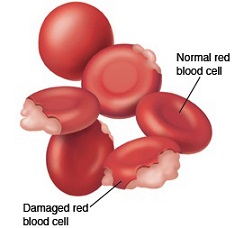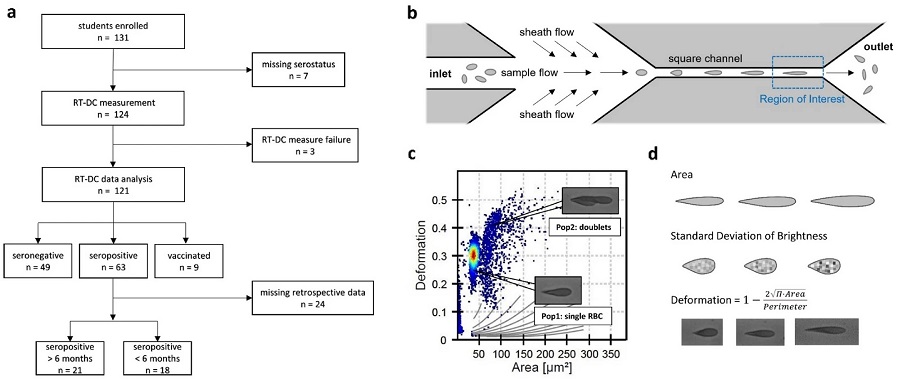BREAKING NEWS! German And Swiss Researchers Discover Increased Red Blood Cell Deformation In Children And Adolescents After SARS-CoV-2 infection!
COVID-19 News - Red Blood Cells – Deformed - Children And Adolescents After SARS-CoV-2 infection Jun 18, 2023 1 year, 10 months, 2 days, 2 hours, 36 minutes ago
Alarming Findings Show That Children And Teens Should Be Clinically Monitored In the Post COVID Phase.
COVID-19 News: In an alarming discovery, researchers from Technische Universität Dresden in Germany, the University of Zurich, and the University Hospital Zurich in Switzerland have identified a significant increase in red blood cell (RBC) deformation among children and adolescents who have contracted the SARS-CoV-2 virus. The study findings shed new light on the understanding of COVID-19 pathophysiology and may provide crucial insights into disease progression and severity in younger individuals.

Past
COVID-19 News reports had already showed that SARS-CoV-2 could damage red blood cells and also affect their production in a variety of ways.
https://www.thailandmedical.news/news/must-read-research-reveals-that-covid-19-attacks-hemoglobin-in-red-blood-cells,-rendering-it-incapable-of-transporting-oxygen--current-medical-protoco
https://www.thailandmedical.news/news/covid-19-latest-sars-cov-2-may-target-red-marrow-and-prevent-formation-of-new-erythrocytes--vitamin-b12-supplementation-important
https://www.thailandmedical.news/news/sars-cov-2-news-study-shows-that-release-of-immature-blood-cells-from-bone-marrow-signifies-covid-19-severity
https://www.thailandmedical.news/news/covid-19-news-sars-cov-2-infections-lead-to-buildup-of-oxysterols-in-erythrocytes-which-can-be-used-as-a-biomarker-for-disease-severity
https://www.thailandmedical.news/news/breaking-covid-19-news-sars-cov-2-also-infects-and-impairs-hematopoietic-stem-cells
COVID-19 has been primarily associated with severe symptoms and fatalities in older patients, while children and adolescents often display mild or asymptomatic cases. However, this latest study has uncovered a previously unrecognized aspect of the virus's impact on the younger population. By employing real-time deformability-cytometry (RT-DC), a cutting-edge technique, the study team analyzed the morphological and mechanical characteristics of RBCs in 121 students from secondary schools in Saxony, Germany.
The results of the study demonstrated a remar
kable increase in median RBC deformation among SARS-CoV-2-seropositive children and adolescents, compared to those who tested negative for the virus.
However, this increased deformation was observed only within the first six months after COVID-19 infection. Interestingly, there were no discernible differences in RBC area between the seropositive and seronegative groups of adolescents.
This discovery suggests that the degree of RBC deformation can potentially serve as a valuable indicator of the clinical course of COVID-19. In particular, increased RBC deformation was associated with milder cases of the disease. By monitoring RBC deformation, healthcare professionals could gain valuable insights into disease progression and adjust treatment strategies accordingly.
The study findings provide new evidence supporting the hypothesis that SARS-CoV-2 directly affects RBC deformation. Structural damage to the RBC membrane proteins and lipids caused by the virus may lead to fluidization of the cell membrane and subsequent increased deformation. Furthermore, the immune complex deposition on RBC membranes in COVID-19 patients, as well as inflammation-induced mechanical damage, could contribute to the observed alterations in RBC deformation.
Moreover, the study found that complete vaccination against SARS-CoV-2 was also associated with increased RBC deformation. This unexpected finding suggests a potential immune response to the spike protein of the virus, requiring further investigation to fully understand its implications.
 Depiction of the sample flow, real time deformability cytometry measurement and cell classification. Study design and paradigm. (a) Upon informed consent 131 students between 11 and 18 years old have been enrolled into the ImmunCOVID19-study. Due to missing information of the serostatus, seven students were excluded. RT-DC of peripheral blood was performed in 124 participants of which three had to be excluded due to measure failure. Results of 121 students were analyzed of which 49 were seronegative and 63 seropositive for SARS-CoV-2-IgG and 9 students had complete status of vaccination. In a subanalysis, seropositive participants were classified according to time of infection. Participants with a positive serostatus (from previous SchoolCoviDD19 study visits) or positive PCR test more than 6 months ago were categorized as “seropositive > 6 months “ (n = 21). Participants with negative serostatus in the SchoolCoviDD19 study visits more than 6 months ago or with positive PCR test within the past 6 months were classified “seropositive < 6 months “ (n = 18). Due to incomplete retrospective data, 24 subjects had to be excluded from the subgroup analysis (b) The illustration shows the operating principle of the RT-DC measurement. Diluted peripheral blood was introduced to the microfluid chip over an inlet. An additional lateral sheath flow created a constant flow of blood cells through the square channel which induced cell deformation through capillary shear stress. Images of the cells were taken with a highspeed microscope at 3000 fps in the last third of the channel (Region of Interest) before the suspension was discharged over an outlet. (c) All cells of one RT-DC measurement are plotted according to their deformation and cell size. Population 1 represents intact, single red blood cells (RBCs). Population 2 represents groups of two or more erythrocytes attached to each other. All other populations represent damaged erythrocytes and other cell types such as thrombocytes. Only population 1 was used for further analysis. (d) Erythrocytes were analyzed according to area of the cell, standard deviation of brightness and deformation as shown exemplarily for the three parameters. Information on area and standard deviation of brightness were extracted from the cell images in ShapeOut. Deformation was calculated as a ratio of area and perimeter.
Depiction of the sample flow, real time deformability cytometry measurement and cell classification. Study design and paradigm. (a) Upon informed consent 131 students between 11 and 18 years old have been enrolled into the ImmunCOVID19-study. Due to missing information of the serostatus, seven students were excluded. RT-DC of peripheral blood was performed in 124 participants of which three had to be excluded due to measure failure. Results of 121 students were analyzed of which 49 were seronegative and 63 seropositive for SARS-CoV-2-IgG and 9 students had complete status of vaccination. In a subanalysis, seropositive participants were classified according to time of infection. Participants with a positive serostatus (from previous SchoolCoviDD19 study visits) or positive PCR test more than 6 months ago were categorized as “seropositive > 6 months “ (n = 21). Participants with negative serostatus in the SchoolCoviDD19 study visits more than 6 months ago or with positive PCR test within the past 6 months were classified “seropositive < 6 months “ (n = 18). Due to incomplete retrospective data, 24 subjects had to be excluded from the subgroup analysis (b) The illustration shows the operating principle of the RT-DC measurement. Diluted peripheral blood was introduced to the microfluid chip over an inlet. An additional lateral sheath flow created a constant flow of blood cells through the square channel which induced cell deformation through capillary shear stress. Images of the cells were taken with a highspeed microscope at 3000 fps in the last third of the channel (Region of Interest) before the suspension was discharged over an outlet. (c) All cells of one RT-DC measurement are plotted according to their deformation and cell size. Population 1 represents intact, single red blood cells (RBCs). Population 2 represents groups of two or more erythrocytes attached to each other. All other populations represent damaged erythrocytes and other cell types such as thrombocytes. Only population 1 was used for further analysis. (d) Erythrocytes were analyzed according to area of the cell, standard deviation of brightness and deformation as shown exemplarily for the three parameters. Information on area and standard deviation of brightness were extracted from the cell images in ShapeOut. Deformation was calculated as a ratio of area and perimeter.
The implications of this research are far-reaching. The ability to identify specific changes in RBC properties associated with SARS-CoV-2 infection in children and adolescents could significantly enhance the understanding of COVID-19's pathophysiological mechanisms. Moreover, this knowledge could help monitor and predict the different clinical courses of the disease, ranging from asymptomatic cases to critical illness and prolonged recovery.
Understanding the physiological processes that allow children and adolescents to recover successfully from mild COVID-19 cases may hold the key to unlocking insights into severe cases and the development of Long-COVID-19 syndrome. By employing RT-DC as a point-of-care test, healthcare professionals could potentially utilize RBC deformation as a diagnostic tool to assess disease severity quickly and accurately.
The study findings were published in the peer reviewed journal: Scientific Reports (Nature).
https://www.nature.com/articles/s41598-023-35692-6
For the latest
COVID-19 News, keep on logging to Thailand Medical News.

